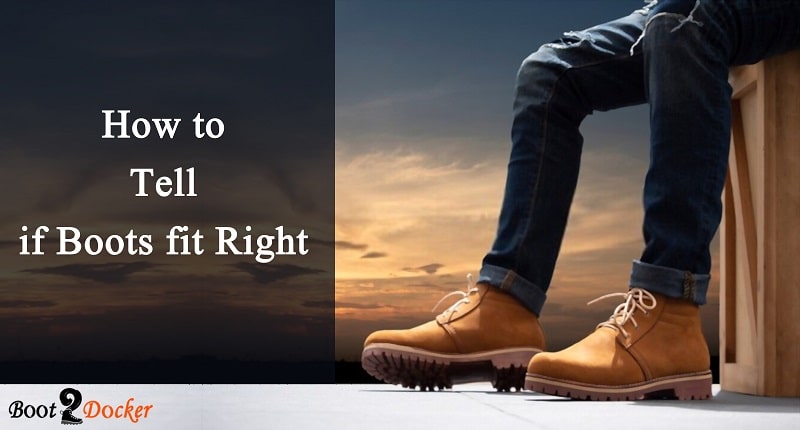How to Tell if Boots fit Right
by James Miller
Boots are the ideal footwear for both men and women during fall and winter. They keep your feet dry, warm and have a practical, ready-for-anything vibe to them. Acquiring a new pair can be a nerve-racking experience especially if you are left undecided if the boot fits you properly or not. Buying an ill-fitting pair may simply be one of the worst wardrobe decisions you will ever make. Essentially, wearing them would not look or feel as amazing as you hoped it would be. It can result in some serious pain and discomfort which defeats the purpose of buying the boots in the first place. The guide below will provide extensive insight into the key factors to consider when obtaining the right boot fit.
Contents
What Are the Key Factors to Consider When Choosing the Perfect Boot Fit?
The Flex Point

Arguably, one of the most vital factors to consider when acquiring a new pair of boots is the flex point. You can easily test out your boot’s flex point by taking a short walk around with your boots on. We refer to how the shoe bends naturally as the flex point. It appears as a natural crease where your foot flexes. This is usually at the point where your toes and the ball of your feet meet. If you happen to wear a boot that flexes too close to the toe cap or in the center, then it is not the perfect fit for you.
Wearing them will result in some unwarranted health issues. They result in extra friction with your feet and the boots do not convey the right amount of support. You are likely to experience pain and plantar fasciitis may soon follow. Besides, some boot varieties are made from stiff leather. Unsurprisingly, they do not flex easily but you can still wear them though it may take a while to break them. Eventually, the pair may end up being an amazing fit. Another method for checking for the flex point is to note the widest portion of the boot. The point where your foot is widest should match where the boot is also widest.
The Heel
In most instances, buying a new pair of boots involves a little heel slippage. This is perfectly normal as long as the heel moves by only a quarter to half an inch. Anything more denotes a small boot size. Boots usually have a break-in period during which the leather and the insoles take up the shape of your foot. It is thus common to find your newly acquired boots with a quarter-inch heel slip that fits you perfectly in a matter of weeks. If the boot’s heel never snugs up your foot, then you’re likely to start feeling the effects of the bothersome lack of space. This is since the heel slippage that is supposed to confer the extra space is absent. Before making the hasty decision of discarding the pair, you should break in your boots first before putting a grip on them. This since the discomfort you may be feeling may be due to stiff leather.
The Width
If you haven’t noticed by now, your foot takes up different widths during the day and may thus end up being narrower or wider on different instances. On waking up, your foot is from rest and is thus its narrowest. However, after a long day of standing and walking, it can swell up to half a size larger. The perfect time to test out a new pair of boots is thus in the afternoon when your feet are at their largest size. Notably, your feet do not get any longer, but the swelling makes them a bit wider.
Boots often come in an array of widths ranging from B which is extra narrow to EEE which is triple wide. Most manufacturers offer boots in D (regular) as well as E (wide) sizes. It is better to seek out a brand with an even greater range of boot widths. Once you start feeling a prickly sensation after a long while with your boots on, then it may not have the right width for you. Now you can consider the possibility of your feet swelling when testing out a new pair of boots.
The Arch
Most people do not need extra arch support which is welcomed news by boot enthusiasts. This is since most boots do come with in-built arch supports. However, people with flat feet have a much higher incidence of plantar fasciitis and thus need more arch support. This is the key factor to consider when picking a boot size as they may need to add an orthotic insole. It often changes how your boot fits.
The best way to determine whether your new pair fits is to bring your insole along when shopping for new boots. Online shoppers, will, however, not have this luxury. Luckily, in this modern day and age, some slim orthotics easily slip into your boots despite limited space. There is thus no need to alter your boot size if you’re planning to add an orthotic. Simply go with your natural size that should have the right amount of space you need.
The Toe Box Room
One of the least effective ways of checking a boot’s fit is pressing down on the toe-box with your thumb. A properly fitting pair leaves an inch of room for your toes. However, having more space does not mean you should look for a smaller pair. It is much more critical to ensure that your boot has a proper width and heel fit. These are the parts that will most likely hurt your ankles and feet as well as make your pair unwearable.
Having less than an inch of free space for your toes is pushing the small side. You are at the risk of developing hammertoe if your toes stay cramped up for long. Hammertoes are extremely painful and will likely reduce your enthusiasm for closed shoes. Getting the right toe fit is vital but also factor in other variables when making your decision.
Your Socks
The socks you pick to wear with your boots may be the difference between a comfortable stroll and a torturous one. A thick pair of socks can increase the overall foot size by half a size. This means if you tested out a new pair of boots with thick socks and later choose to wear thin socks, the boots may end up feeling a bit loose. Thick socks are an excellent choice for the cold season as they confer an extra layer of protection from the elements. It is thus advisable to find an appropriate fit when wearing thick socks. Though the pair may end up feeling loose when wearing thin socks during hot seasons, chances are your feet may swell and take up the extra space.
Notably, the flex point, the shoe width, the arch, the toe box room and the type of socks are a few of the key factors to consider when picking a pair of boots with the right fit.
 |
 |
 |
 |

About James Miller
James Miller is a dedicated individual based in the vibrant city of San Francisco, CA, USA. His unwavering passion lies in the realm of construction, where he finds fulfillment in exploring and documenting various facets of construction equipment and processes. A graduate of the University of California Merced, James holds a dual degree in mechanical and electrical engineering, which has equipped him with a solid foundation in technical knowledge.
With a keen eye for detail and a knack for articulation, James has channeled his enthusiasm into writing about the intricacies of construction gear and methodologies. His insightful writings offer valuable insights to both industry professionals and curious enthusiasts, shedding light on the machinery and techniques that shape the built environment.
James Miller's educational background in mechanical and electrical engineering lends credibility to his work, allowing him to delve into the technical nuances of construction with precision. His passion for sharing knowledge and fostering understanding in the construction field is evident in his contributions, making him a respected voice in the industry.
Thoughts on "How to Tell if Boots fit Right"
 |
 |
 |
 |
Top Boot Reviews
Get FREE Boots Gifts now. Or latest free toolsets from our best collections.
Disable Ad block to get all the secrets. Once done, hit any button below
 |
 |
 |
 |